Whether you believe in the existence of the elusive 14-foot walking primate known commonly as Bigfoot or not, the cult hit series Finding Bigfoot on Animal Planet has something to offer you, due mainly to Ranae Holland (out lesbian and research biologist) returning as one of the show’s stars. And if you happen to be a Sasquatch skeptic, well, then Holland really plays for your team, as she is the show’s resident non-believer.
Holland was first introduced to the phenomena of Bigfoot as a little girl when she would bond with her father by watching movies and television shows and by reading articles about the authenticity of the species together. Since the death of her father in 2003, Ranae has found a way to keep his memory close to her through her field research and subsequently the series. Holland’s scientific expertise and analytical know-how often puts her at odds with completely succumbing to the myth, but it is her openness to be disproved that makes her one of the more relatable people on the show.
“Finding Bigfoot” has a Blair Witch-ian quality to it wherein cameras follow the four-person team of Bigfoot researchers across the country–often as they patrol the blackness of the wildernesses in order prove or disprove the myth of the elusive beast. The team is made up of members from the Bigfoot Field Researchers Organization (BFRO) and is comprised of a commercial fisherman (Bobo), a professional educator (Cliff), the BFRO president (Matt) and skeptical scientist (Ranae); each member on a mission to find out if Bigfoot really exists.
SheWired got a chance to talk to Holland about the series, how she spends her time when she’s not searching for giant primates and why those pictures of Bigfoot are always so darn grainy.
SheWired: Prior to joining the series have you always had an interest in Bigfoot?
Ranae Holland: Yeah, my background is that I grew up in South Dakota, and my special time with my father was watching movies with him. At the time there was a 1970’s-era Bigfoot movie craze, and we spent a lot of our quality time watching those. It wasn’t until made dad passed away in 2003, and I was going through some of his belongings, that I came upon a Bigfoot book and an old video and it brought back vivid memories of my father. That’s really what got me to meet the members of the BFRO (Bigfoot Field Research Organization).
How did you get involved with the series itself?
Well, I am fascinated by the consistent mythology of it. For hundreds of years, some will argue thousands, there is the belief that there is this undiscovered bipedal primate running around North America and yet there is no, in my opinion, tangible evidence of this. And how it persists is just fascinating to me…
So it really originated with my love of the environment, my love of fieldwork, and feeling so close to my dad by hearing all these stories [about Bigfoot.] I feel like I’m that little girl again on my dad’s lap. But how I got involved in the show itself was that I was living in Seattle doing fieldwork, and while doing that I met Matt Moneymaker (president of BFRO). We developed a relationship via emails and telephone and we would talk about Bigfoot -- and I would offer my scientific feedback. We had that symbiotic relationship for about six or seven years. At one point a production company approached the Discovery channel with an idea for the show and the BRFO, and of course, Matt, was a main part of it. And I understand that for about nine months they were looking to fill, what would be my role on the show, which was a person that encompasses ‘the eye of the viewer,’ a nonbeliever – and the field expert. Initially, I was very resistant to doing this because, I am a young scientist that studies aquatics and fisheries, and the last thing I wanted to do was be affiliated with belief in Bigfoot. So it actually took me a while to come around.
More on next page...
\\\
(continued)
Finding Bigfoot has become very successful on Animal Plant, were you surprised at all at how popular the show has become?
Yes and no. I genuinely love Bigfoot stories. I really do. Regardless of the fact of this show happening, I have always had a huge interest. And it’s really interesting how many people have a story of a Bigfoot encounter. And these same people have a belief about it. A big part of the show is people sharing their stories, so I completely register and connect with how that is a huge appeal of the show.
The only thing that is surprising is to have had this whole experience (of being a part of the show) be so personal to me. That is the part that I was pretty caught off guard by. This whole ride, the past two years -- all came full circle with my dad. When we filmed the pilot it was in the middle of nowhere Alaska on this island where I actually went to grieve my father’s death back in 2003. The fact that we went there to shoot the pilot - I was like, “wow universe.” It gives me chills. And when we go to these town hall meetings and there will be 6 to 10 young kids there with their dads or moms -- in that moment, when I see that little kid, and that smile, and that interaction… it chokes me up at times and that is why I am out there doing this.
Is there any evidence that you’ve come across through the series thus far that has been so compelling that it has tipped you in favor of becoming more of a believer? Or is the jury still out for you?
Well I came into the situation with a mixture of feelings. As a research scientist I can’t wrap my head around the fact that there hasn’t been any further evidence – show me the proof. Ok you’ve got this compelling story, and you’ve got some kind of video footage, but nothing that is truly irrefutable. The majority of stuff I have seen I can explain it away, but in season one we went to Oregon and we captured some audio that I can’t just write off. It’s exciting because it definitely resonates with that 10-year-old girl inside me, and I couldn’t just scientifically eliminate it.
What is the dynamic like between you and the rest of the team (Bobo, Cliff, and Matt)? Do you ever argue? Are there ever moments when you roll your eyes because they claim they heard or saw something, or does searching for a Bigfoot have the same rules of improv theater where you are not allowed to negate or deny what your team member says?
Oh absolutely we argue. I think if you put four people, or any people, through such rigors and you add to it that we are all passionate and strong, and then you throw in this arguable/controversial subject… it’s going to happen. Those guys are passionate and all fervently believe and have their belief system. And I am the one arguing with them most of the time, but I come in open minded and we all show a mutual respect for each other. All four of us have very different skill sets and we try to embrace that. Of course, you know, you get tired and cranky, but at the end of the day we are all supporting each other and they are all great guys. But a lot of time, I haven’t seen what they saw.
More on next page...
\\\
(continued)
So I have some questions for you being the novice Sasquatch researcher that I am. Can you tell me a bit more about what you are listening for when you are out in the field doing your research? For example some of your team members claim to hear knocking sounds. What is that? What are you listening for out there?
Well, people that are Sasquatch aficionados theorize that these large primates communicate with each other in ways, not just vocally. They will use tools and believe that they make tree knocks or wood knock sounds to locate each other without giving each other up.
When I am out there I am looking to rule sounds out. I first and foremost am looking to rule out that it’s people and then I go down from there – i.e. some other larger animal. Ninety percent of the time there is a more plausible explanation when we hear these knocks.
Is Bigfoot an herbivore, carnivore or omnivore? And if he / she does eat meat, are you afraid that he/she might eat you?
The theory is that he is an omnivorous species similar to you or I, and gorillas etc… As far as for our personal safety out there, you know, the lovely history of Sasquatch, from anything I could get my hands on, tells us that there really is no story of a Sasquatch attacking or eating another person. Most of the larger animals have an expenditure of safety -- how much are they going to risk to take down a prey without getting injured to eat it? And when they encounter humans they approach us the same way – what is the cost benefit of me encountering you and then putting the distance.
Why do you think that Sasquatches are so darn illusive? Do you think they are smart enough to know humans are looking for them? And what is with all the video footage that we do have of one always being so grainy?
You know I’m out here, and there is something else that as an adult and as a scientist I can't rationalize. The phenomenon is so intriguing, so fascinating to me. But how come all these people are seeing this but we don’t have any remains, we don’t have DNA and we don’t have this video that is irrefutable? Why is it so difficult?
In fairness to pro-Bigfoot people there are vast amounts of wilderness that are impenetrable, rarely visited - no need for people to be there. If there were some species that had a viable reproductive population and didn’t want to encounter people and was adverse to encounters, in theory, I guess it could happen that we wouldn’t ever find one. However, to add to their argument, a natural species that we know of and have some remnants of, that was a primate and that was estimated to be in the ten to fourteen foot range – well, there has been a collective shoe box full of molars and pieces of the jaw bone that has been found and when they reconstructed it, and made the assumption of what they thought the subject would have looked like, the result is what a Sasquatch is reported to look like.
I love how I argue for their point [laughs], but it’s not like I am out here to say I am right they are wrong. I’m here to show my beliefs and my opinions and be respectful of theirs.
More on next page...
\\\
(continued)
In the series we see you often camping alone in the woods. Are you afraid at all of what lurks around these dark corners, Sasquatch or no Sasquatch? Because I’m a little afraid for you.
At times when we get down to it, I mean obviously it’s reality TV and we have a backpack camera on us, but it’s obvious we have a cameraman with us too. But to answer you question, am I scared? I have a very adventurous spirit. I love the woods. I thrive when I am in the middle of nowhere. The happier I am, the bigger my smile. But being out in these breathtaking areas in the middle of the day is one thing, and that is what I am used to professionally, but being out there at night is different. There are different sounds. You have different sensations. The woods come alive in a completely different way. As far as my personal safety at night, you walk different on the ground and we often do river walking at night. In my day-to-day field research I have been used to being an arm’s distance from brown bears, and once you learn to deal with apex predators then you have to have a love and respect for the environment and the animals within. So it’s really not the animals that concern me -- it’s humans that are doing what they shouldn’t be doing in the woods.
Does traveling in search of Bigfoot keep you away from home a lot?
We just spent over fourth months on the road and then we had a break that was a three month stint, but I’m used to that. Being a field biologist, I’m often away from home.
And where is home for you?
I live in Seattle, Washington. And I also split my time between here at New York, but Seattle is home.
What is an average day like for you when you’re not out looking for Sasquatches? Are you single? Do you have hobbies?
Well to answer you question, I am fiercely single (laughs). I recently came out of six-year relationship that ran its course. As for hobbies, my two loves are music and the environment. I try to combine my love of music and the environment with nonprofits charity – to get my musician friends together for concerts that benefit environments, especially, river restoration and water systems.
Survival Scenario: You are alone in a forest and you see a Bigfoot, what do you do?
Well, if I were to see a Sasquatch... I’d pinch myself; I’d rub my eyes; then I honestly would... I’m sorry, but I would run atit. Or maybe slowly approach it? I wouldn’t run away – because I’d be thinking ‘you’re not real so I’m gonna run you down and I’m gonna pinch ya.” Are you real or am I going to pull the suit off? I need to know, one way or the other. But if I’m running, I’m running at it.
Finding Bigfoot airs Sundays at 10pm on Animal Planet.





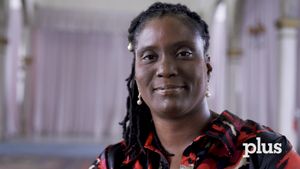






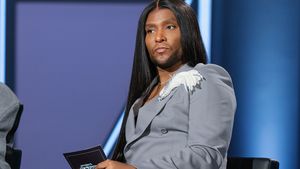



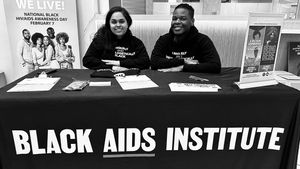












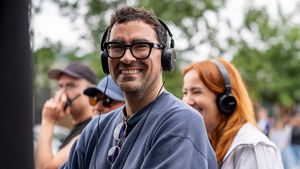







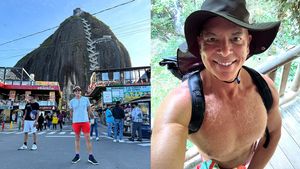

















































 Cindy Ord/Getty Images
Cindy Ord/Getty Images

























